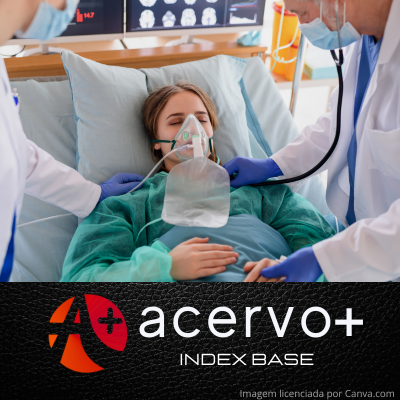Análisis de indicadores de funcionalidad y mecánica ventilatoria de pacientes hospitalizados en una Unidad de Cuidados Intensivos
##plugins.themes.bootstrap3.article.main##
Resumo
Objetivo: Analisar os marcos de funcionalidade e dados de mecânica ventilatória de pacientes internados em uma Unidade de Terapia Intensiva (UTI). Métodos: Trata-se de um estudo observacional, prospectivo e quantitativo, com busca ativa nos prontuários de pacientes maiores de 18 anos e com mais de 24 horas de ventilação mecânica após admissão na UTI, para registro de dados demográficos, clínicos, epidemiológicos, de mecânica ventilatória e funcionalidade. Resultados: Foram incluídos 51 prontuários, com gravidade média de 68,9 ± 20,3 no SAPS 3. 49% realizaram a postura sentada à beira do leito, enquanto 4% evoluíram para a deambulação. Taxa de mortalidade de 72,5% e 84,3% dos pacientes permaneceram com Driving Pressure (DP) média abaixo de 15, além do coeficiente de correlação fraco para o tempo de VM (r 0,025; p > 0,05), para o tempo de internação (r 0,000; p > 0,05), para a gravidade (r 0,01; p > 0,05) e para o desfecho (r 0,265; p > 0,05), que está incluído na alta ou óbito na UTI. Conclusão: Os marcos da funcionalidade e da mecânica ventilatória não apresentaram associação estatisticamente significativa com a duração da VM, internação, gravidade e mortalidade dos pacientes.
##plugins.themes.bootstrap3.article.details##
Copyright © | Todos os direitos reservados.
A revista detém os direitos autorais exclusivos de publicação deste artigo nos termos da lei 9610/98.
Reprodução parcial
É livre o uso de partes do texto, figuras e questionário do artigo, sendo obrigatória a citação dos autores e revista.
Reprodução total
É expressamente proibida, devendo ser autorizada pela revista.
Referências
2. AOYAMA H, et al. Association of Driving Pressure With Mortality Among Ventilated Patients With Acute Respiratory Distress Syndrome: A Systematic Review and Meta-Analysis. Crit Care Med. 2018; 46: 300-306.
3. BECERRA-MUÑOZ VM, et al. Clinical profile and predictors of in-hospital mortality among older patients hospitalised for COVID-19. Age Ageing. 2021; 50: 326-334.
4. BEITLER JR, et al. Ventilator-induced Lung Injury. Clin Chest Med. 2016; 37: 633-646.
5. BLANK RS, et al. Management of One-lung Ventilation: Impact of Tidal Volume on Complications after Thoracic Surgery. Anesthesiology. 2016; 124: 1286-95.
6. BROWER RG, et al. Ventilation with lower tidal volumes as compared with traditional tidal volumes for acute lung injury and the acute respiratory distress syndrome. N Engl J Med. 2000; 342(18): 1301-8.
7. CALLEGARI-JACQUES SM. Biostatistics: principles and applications. Porto Alegre: Artemed, 2003.
8. CHEN B, et al. A systematic review and meta-analysis of the effects of early mobilization therapy in patients after cardiac surgery. Medicine (Baltimore). 2021; 100: 25314.
9. CHEN Z, et al. Higher vs. Lower DP for Ventilated Patients with Acute Respiratory Distress Syndrome: A Systematic Review and Meta-Analysis. Emerg Med Int. 2019; 4654705.
10. GODINJAK, et al. Predictive value of SAPS II and APACHE II scoring systems for patient outcome in a medical intensive care unit. Acta Med Acad. 2016; 45: 97-103.
11. GOLIGHER EC, et al. Mechanical Ventilation-induced Diaphragm Atrophy Strongly Impacts Clinical Outcomes. Am J Respir Crit Care Med. 2018; 197: 204-213.
12. GUÉRIN C, et al. Effect of driving pressure on mortality in ARDS patients during lung protective mechanical ventilation in two randomized controlled trials. Crit Care. 2016; 20: 384.
13. LAFFEY JG, et al. Potentially modifiable factors contributing to outcome from acute respiratory distress syndrome: the LUNG SAFE study. Intensive Care Med. 2016; 42: 1865-1876.
14. LANSPA MJ, et al. Driving pressure is not associated with mortality in mechanically ventilated patients without ARDS. Crit Care. 2019; 23: 424.
15. LI Y, et al. The effect of driving pressure-guided ventilation strategy on the patients with mechanical ventilation: a meta-analysis of randomized controlled trials. Eur Rev Med Pharmacol Sci. 2022; 26: 5835-5843.
16. LIM ZJ, et al. Case Fatality Rates for Patients with COVID-19 Requiring Invasive Mechanical Ventilation. A Meta-analysis. Am J Respir Crit Care Med. 2021; 203: 54-66.
17. MAO JY, et al. Fluctuations of driving pressure during mechanical ventilation indicates elevated central venous pressure and poor outcomes. Pulm Circ. 2020; 10: 2045894020970363.
18. MATHIS MR, et al. Intraoperative Mechanical Ventilation and Postoperative Pulmonary Complications after Cardiac Surgery. Anesthesiology. 2019; 131: 1046-1062.
19. MCWILLIAMS D, et al. Rehabilitation Levels in Patients with COVID-19 Admitted to Intensive Care Requiring Invasive Ventilation. An Observational Study. Ann Am Thorac Soc. 2021; 18: 122-129.
20. NETO AS, et al. Association between driving pressure and development of postoperative pulmonary complications in patients undergoing mechanical ventilation for general anaesthesia: a meta-analysis of individual patient data. Lancet Respir Med. 2016; 4: 272-80.
21. ORBAN JC, et al. Causes and Characteristics of Death in Intensive Care Units: A Prospective Multicenter Study. Anesthesiology. 2017; 126: 882-889.
22. PARK M, et al. Driving Pressure during Thoracic Surgery: A Randomized Clinical Trial. Anesthesiology. 2019; 130: 385-393.
23. PATON M e LANE R, et al. Early Mobilization in the Intensive Care Unit to Improve Long-Term Recovery. Crit Care Clin. 2018; 34: 557-571.
24. RAMIN S, et al. Driving pressure is not predictive of ARDS outcome in chest trauma patients under mechanical ventilation. Anaesth Crit Care Pain Med. 2022; 41(4): 101095.
25. SAHETYA SK, et al. Association between hospital mortality and inspiratory airway pressures in mechanically ventilated patients without acute respiratory distress syndrome: a prospective cohort study. Crit Care. 2019; 23: 367.
26. SILVA VS, et al. Mobilization in the Intensive Care Unit: systematic review. Physiotherapy and Research. 2014; 21: 398-404.
27. SILVEIRA JÚNIOR JCD, et al. Driving pressure and mortality in trauma without acute respiratory distress syndrome: a prospective observational study. Rev Bras Ter Intensiva. 2021; 33: 261-265.
28. VANHOREBEEK I, et al. ICU-acquired weakness. Intensive Care Med. 2020; 46: 637-653.
29. YANG Q e DU JL, et al. Mortality rate and other clinical features observed in Open vs closed format intensive care units: A systematic review and meta-analysis. Medicine (Baltimore). 2019; 98: 16261.

